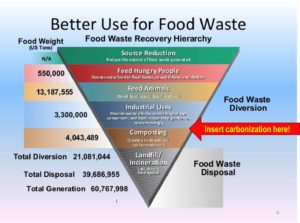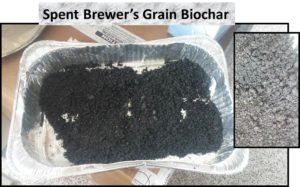The US EPA created the Food Waste Recovery Hierarchy (FWRH) in an effort to divert various organics towards the highest and best end uses. Sadly an inordinate amount of food waste, roughly 65% of the total waste stream, still ends up getting incinerated or landfilled. Both of these disposal options waste valuable nutrients and landfilling organics generates CH4 which contributes to climate change. Newer technologies are evolving that can harvest nutrients and prevent emissions and even sequester carbon.
The New York State Pollution Prevention Institute just rolled out an updated Organics Resource Locator, a great resource to identify what and where various organics are produced. The database is meant to facilitate connections between producers of various underutilized organics (e.g. Food Processors, Restaurants, Institutions, etc.) with those that might want to use them (e.g. Compost facilities, Anaerobic Digestion operators, Food Banks, CAFOs, etc).
Wherever possible food waste can and should be diverted to feed humans and livestock. However this is often difficult to manage if proximity to end users with a consistent need for a particular kind of food waste is lacking. Sorting and transportation are often costly and time consuming as well.
Anaerobic digesters (AD) can take certain kinds of organics and convert it into energy but ADs can be finicky and require a balance of various inputs in order to work efficiently. There is also a significant amount of high moisture digestate that remains at the end of the AD process. Composting is a good option but operators often don’t want dairy, meat, fish or oils or any foreign objects mixed it. It can also be constrained by seasons and by the need to balance carbon and nitrogen levels.
Carbonization via pyrolysis or gasification could be a very viable option for certain types of organic waste streams. High moisture content (i.e. >25%) and heterogeneous waste streams have traditionally not been a primary target for feedstock for biochar. Carbonizing this kind of waste can be very difficult and often results in char which is low in carbon, with low surface area and potentially high salinity – not the greatest kind of char for soil amendments if you are looking for yield increases. However a recent study from Singapore showed that gasifying blended food waste & woody biomass could produce high quality biochars that can be used effectively in nutrient poor, acidic soils.
Other waste streams which are more uniform and less seasonal could make for more attractive carbonization targets. Take the recent surge in craft and micro-breweries as an example. Each brewery has to find an outlet for their spent brewer’s grain (SBG), a high moisture and high protein residual from the brewing process. Breweries in rural areas happily provide this to cattle or pig farmers that are willing to pick it up, but that is less feasible for urban brewers. I am currently involved in a project focusing on pyrolyzing SBG which has recently been trialed rather successfully (see pictures below) once it was mixed with dryer feedstock to reduce MC. Overall the char came out looking very nice though we are currently putting it through its paces to understand optimal end uses for high temperature SBG char. Updates on this front will be presented at the Biochar 2016 Conference in August so I hope to see you there!!



